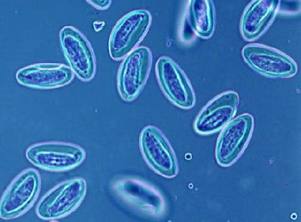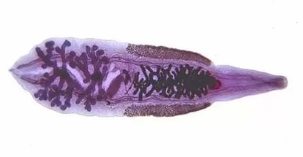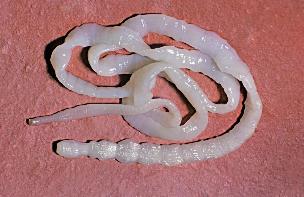
Intestinal parasites are one of the most common diseases among children and adults. In humans can parasite different types of worms. There is the belief, very far away from the medicine, that helminths affect only the digestive tract, in reality, worms can be parasitic in nearly all organs – the liver, the lungs, the heart, the brain of the head, as well as in the muscle tissue, the subcutaneous tissue and in the eye. In the article it says about what worms are to human beings.
Classification
There are a large number of helminths that can affect a person, here are the most common of them. Most of the worms belonging to any of the 3 groups – trematody, roundworms (or nematodes.
Trematody is a class of worms infect flat shape, it is known about 40 species of worms that affect humans. The most common:
- jasmine or anthrax Fluke (called opisthorchiasis);
- schistosoma (causing schistosomiasis).
Cestodes is tape flat worms. The representatives of cestodes lack digestive system. Often the person surprised:
- bullish tsepen (called beef tapeworm infection);
- swine tsepen (called cysticercosis);
- Echinococcus (called echinococcosis).
Nematodes are round worms, although abdominal. Common helminthes that affect humans:
- ostritsy;
- ascaride;
- vlasoglav.
Worms in humans — the symptoms of the picture (most of the helminths affects the digestive tract, hence nausea and vomiting, diarrhea or constipation, intestinal obstruction, with or without cause thinning, lack of appetite or excessive hunger):
Jasmine or anthrax Fluke

Jasmine or anthrax Fluke – small parasite, its form of group liver flukes. The causative agent of the disease opisthorchiasis. The length of the fluke cat reaches 8-18 mm, width – 1,2-2 mm Parasite develops in the bodies of the two masters — intermediate and final. Intermediate teacher – the molluscs and fishes of the carp, the man.
Along with the stools of infected people and animals, the eggs fall into the water, sweet the water, there are swallowed by the molluscs. In the body of the mollusc, the eggs reach the invasive stage – cercaria, cercaria out of the clam and is embedded in the body of tents, or fall into their bodies by eating fish shellfish. In the body of the fish parasite develops before the meta cercaria, located in the cyst, its size, reach 0,17-0,21 mm
By eating fish infected, infected with the man, in his body of meta-cercaria leave cysts, from the stomach and intestine go to the liver and the bile ducts. In these organs they are parasite, and through 10-12 days to reach Ripe stage, they begin to lay eggs. In the human body the fluke feline can parasite up to 10 to 20 years.
Schistosoma
Schistosoma – blood flukes. Is the plane dioecious helminths, in length it reaches from 4-20 mm, width – 0,25 mm Body schistosoma has 2 suckers – oral and abdomen, which are located close to each other. The females of schistosoma longer and thinner than that of the males. In the body of the man there is of the longitudinal slot, which keeps the female. Their eggs with a diameter of 0.1 mm, oval shaped, on the surface of one of the poles is a great spine.
Human schistosoma worms in the definitive role of the teacher choose the people, in their bodies that parasites in the small veins of the colon, abdominal cavity, the uterus, the bladder. Worms feed on blood in part to suck up the nutrients through the cuticle. The eggs of schistosoma transported in the intestine and the bladder, where they are maturing, and are separated to the outside along with the stool or urine. In fresh water the waters of the egg comes out the larva, its intermediate master – molluscs. In the body of the mollusk meta cercaria develop to cercaria for 4-8 weeks.
Bullish tsepen

Bullish tsepen – ribbon-parasite that causes the disease beef tapeworm infection. It is the great worm, able to grow up to 3 meters to 12 meters in length. In the body of the parasite, is the small head of a diameter up to 3 mm, the neck, and around 1000 segments. After the introduction in the body of the person, coupled with the non-processed thermally-infected white meat is fixed to the walls of the intestine using 4 suction cups.
In the hermaphrodite, the segments are deposited the eggs helminths annually to an individual puts up to 600 million eggs. These helminths in the human live as a parasite in the intestine of 20 years or more, if the lack of timely treatment.
Swine tsepen
Swine tsepen, as of a bull, the body has 4 suction cups, but in addition to this, the body helminths still available and dual beater hooks. Reaches two or three meters of length. The pork tsepnja trilobal ovary, with each side of the uterus has 7 to 12 branches. A characteristic feature of this worm – the ability of segments to make us ourselves of the anal opening. After the exit out of your shell becomes dry and bursts, because in the outside environment fall, the eggs helminths. Intermediate the owner of tsepnja can be of the pig and the man.
The principal owner is a person. The intestinal parasitoses in man include pork tsepnja, helminths are found in the intestine of the patient, where it lays its eggs. The infection occurs when the consumption invasive of the meat.
Echinococcus
The causative agent of the conveyed in the length reaches 3-5 mm. It consists of a head, in which are placed the four suckers, and two of the crown of the head, hooks, and three to four segments. The last of the segments has developed the sexual system. Intermediate teacher – cattle, or the man, the end of the owner – the dogs, the wolves. The infection occurs by the oral route through.
Echinococcus found in the small intestine, where the eggs hatch the larvae. With the help of hooks the larvae penetrate the system of the portal vein, where along with the blood of resonate in the liver, the lungs, the muscle tissue.
Ostritsy

Ostritsy – worms, stimulants enterobiasis, the so-called disease of dirty hands. In large measure the spread of the worms to the children. The infection occurs by the oral route and distance learning-pathway. You can detect these worms in the stool.
Females of a helminth type of ostritsy in the length reaching 5 mm to 10 mm, males – 3 millimeters. The shape of the body of the worm spindle a milky white in color. The end of the body in females slightly sharp. The adults feed on worms in the departments of lower small and large intestine human, clinging to the wall with the head vesicle. To lay their eggs in female worms enter into the colon, reptan out and lay their eggs in the anus, after that they die. Slopes of the eggs turn into invaders already through 4-6 hours. The duration of the life of the worms – one or two months.
Ascaride
Ascaride – even some representatives of the class of round worms, parasites, pathogens, living with roundworms. Is helminths yellowish-pink color, have stretched spindle-shape of i, razdelnopolie. The female Ascaris grow up to 20 to 40 cm, males reach a length of 15 to 25 centimeters. Each day, an adult female ascaride gets more than 200 thousand eggs, which, together with the human excrement stand out in the external environment, where through 12-14 days turn into invaders.
In human beings live as a parasite in the gastrointestinal tract, mainly localized in the small intestine. The full cycle of development of invasive eggs to Mature stage takes about 3 months.
Vlasoglav
Vlasoglav – helminths, cause trihozefalez. Helminths are thin brown nematodes with a fine threadlike front and rounded rear end. The female whipworm grow up to 3.5-5.5 cm, and males up to 3-4,5 cm. The larvae of the worms in humans are located in the cecum, where parasites to the stage of puberty, where they lay their eggs. The massive invasion of the helminths can also occupy the large intestine, including the rectum.
Each day the female whipworm put 3.5 thousand eggs. The eggs helminths have a barrel shape, covered in a thick wrap of brown, on the poles are missing, discolored, diacritical mark. The eggs fall to the floor together with the droppings, primary teacher, when conditions are favorable they can keep invaders of the property of up to two years. The duration of the parasitic in the intestine of the human – 5 to 7 years.






































